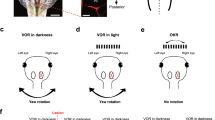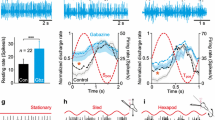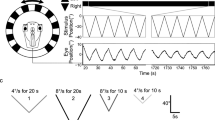Abstract
Vestibulo–ocular reflexes (VOR) are mediated by frequency-tuned pathways that separately transform the different dynamic and static aspects of head motion/position-related sensory signals into extraocular motor commands. Voltage-dependent potassium conductances such as those formed by Kv1.1 are important for the ability of VOR circuit elements to encode highly transient motion components. Here we describe the impact of the Kv1.1 channel blocker 4-aminopyridine (4-AP) on spontaneous and motion-evoked discharge of superior oblique motoneurons. Spike activity was recorded from the motor nerve in isolated preparations of Xenopus laevis tadpoles. Under static conditions, bath application of 1–10 µM 4-AP increased the spontaneous firing rate and provoked repetitive bursts of spikes. During motion stimulation 4-AP also augmented and delayed the peak firing rate suggesting that this drug affects the magnitude and timing of vestibular-evoked eye movements. The exclusive Kv1.1 expression in thick vestibular afferent fibers in larval Xenopus at this developmental stage suggests that the altered extraocular motor output in the presence of 4-AP mainly derives from a firing rate increase of irregular firing vestibular afferents that propagates along the VOR circuitry. Clinically and pharmacologically, the observed 4-AP-mediated increase of peripheral vestibular input under resting and dynamic conditions can contribute to the observed therapeutic effects of 4-AP in downbeat and upbeat nystagmus as well as episodic ataxia type 2, by an indirect increase of cerebellar Purkinje cell discharge.



Similar content being viewed by others
References
Angelaki DE, Cullen KE (2008) Vestibular system: the many facets of a multimodal sense. Annu Rev Neurosci 31:125–150
Straka H, Fritzsch B, Glover JC (2014) Connecting ears to eye muscles: evolution of a 'simple' reflex arc. Brain Behav Evol 83:162–175
Straka H, Lambert FM, Pfanzelt S, Beraneck M (2009) Vestibulo–ocular signal transformation in frequency-tuned channels. Ann NY Acad Sci 1164:37–44
Carriot J, Jamali M, Chacron MJ, Cullen KE (2014) Statistics of the vestibular input experienced during natural self-motion: implications for neural processing. J Neurosci 34:8347–8357
Hänzi S, Straka H (2017) Developmental changes in head movement kinematics during swimming in Xenopus laevis tadpoles. J Exp Biol 220:227–236
Beraneck M, Straka H (2011) Vestibular signal processing by separate sets of neuronal filters. J Vestib Res 21:5–19
Goldberg JM (2000) Afferent diversity and the organization of central vestibular pathways. Exp Brain Res 130:277–297
Eatock RA, Songer JE (2011) Vestibular hair cells and afferents: two channels for head motion signals. Annu Rev Neurosci 34:501–534
Straka H, Vibert N, Vidal PP, Moore LE, Dutia MB (2005) Intrinsic membrane properties of vertebrate vestibular neurons: function, development and plasticity. Prog Neurobiol 76:349–392
Beraneck M, Pfanzelt S, Vassias I, Rohregger M, Vibert N, Vidal PP, Moore LE, Straka H (2007) Differential intrinsic response dynamics determine synaptic signal processing in frog vestibular neurons. J Neurosci 27:4283–4296
Strupp M, Schüler O, Krafczyk S, Jahn K, Schautzer F, Büttner U, Brandt T (2003) Treatment of downbeat nystagmus with 3,4-diaminopyridine: a placebo-controlled study. Neurology 61:165–170
Claassen J, Spiegel R, Kalla R, Faldon M, Kennard C, Danchaivijitr C, Bardins S, Rettinger N, Schneider E, Brandt T, Jahn K, Teufel J, Strupp M, Bronstein A (2013) A randomised double-blind, cross-over trial of 4-aminopyridine for downbeat nystagmus—effects on slowphase eye velocity, postural stability, locomotion and symptoms. J Neurol Neurosurg Psychiatry 84:1392–1399
Strupp M, Teufel J, Zwergal A, Schniepp R, Khodakhah K, Feil K (2017) Aminopyridines for the treatment of neurologic disorders. Neurol Clin Pract 7:65–76
Strupp M, Kalla R, Dichgans M, Freilinger T, Glasauer S, Brandt T (2004) Treatment of episodic ataxia type 2 with the potassium channel blocker 4-aminopyridine. Neurology 62:1623–1625
Strupp M, Kalla R, Claassen J, Adrion C, Mansmann U, Klopstock T, Freilinger T, Neugebauer H, Spiegel R, Dichgans M, Lehmann-Horn F, Jurkat-Rott K, Brandt T, Jen JC, Jahn K (2011) A randomized trial of 4-aminopyridine in EA2 and related familial episodic ataxias. Neurology 77:269–275
Glasauer S, Kalla R, Büttner U, Strupp M, Brandt T (2005) 4-Aminopyridine restores visual ocular motor function in upbeat nystagmus. J Neurol Neurosurg Psychiatry 76:451–453
Glasauer S, Rössert C, Strupp M (2011) The role of regularity and synchrony of cerebellar Purkinje cells for pathological nystagmus. Ann N Y Acad Sci 1233:162–167
Strupp M, Querner V, Eggert T, Straube A, Brandt T (2003) 3,4-Diaminopyridine improves head-shaking nystagmus caused by neurovascular cross-compression. Ann N Y Acad Sci 1004:506–510
Nieuwkoop PD, Faber J (1994) Normal table of Xenopus laevis (Daudin): a systematical and chronological survey of the development from the fertilized egg till the end of metamorphosis. Garland Publishing, New York
Dietrich H, Glasauer S, Straka H (2017) Functional organization of vestibulo–ocular responses in abducens motoneurons. J Neurosci 37:4032–4045
Soupiadou P, Branoner F, Straka H (2018) Pharmacological profile of vestibular inhibitory inputs to superior oblique motoneurons. J Neurol 265(Suppl 1):S18–S25
Branoner F, Straka H (2015) Semicircular canal-dependent developmental tuning of translational vestibulo–ocular reflexes in Xenopus laevis. Dev Neurobiol 75:1051–1067
Lambert FM, Beck JC, Baker R, Straka H (2008) Semicircular canal size determines the developmental onset of angular vestibuloocular reflexes in larval Xenopus. J Neurosci 28:8086–8096
Beraneck M, Lambert FM, Straka H (2008) Membrane properties of central vestibular neurons in larval Xenopus: eco-physiological adaptations to locomotor strategy. Soc Neurosci Abstr 34(169):12
Branoner F, Straka H (2018) Semicircular canal influences on the developmental tuning of the translational vestibulo–ocular reflex. Front Neurol 9:404
Gensberger KD, Wühr M, Hoffman LF, Paulin MG, Straka H (2017) Spike time regularity of horizontal canal afferent fibers as decisive factor for motion encoding in Xenopus laevis tadpoles. Soc Neurosci Abstr 43(225):11
Alviña K, Khodakhah K (2010) The therapeutic mode of action of 4-aminopyridine in cerebellar ataxia. J Neurosci 30:7258–7268
Straka H, Dieringer N (2000) Convergence pattern of uncrossed excitatory and inhibitory semicircular canal-specific inputs onto second-order vestibular neurons of frogs. Exp Brain Res 135:462–473
Straka H, Dieringer N (2004) Basic organization principles of the VOR: lessons from frogs. Prog Neurobiol 73:259–309
Wang H, Kunkel DD, Schwartzkroin PA, Tempel BL (1994) Localization of Kv1.1 and Kv1.2, two K channel proteins, to synaptic terminals, somata, and dendrites in the mouse brain. J Neurosci 14:4588–4599
Kalla R, Teufel J, Feil K, Muth C, Strupp M (2016) Update on the pharmacotherapy of cerebellar and central vestibular disorders. J Neurol 263(Suppl 1):S24–S29
Etzion Y, Grossman Y (2001) Highly 4-aminopyridine sensitive delayed rectifier current modulates the excitability of guinea pig cerebellar Purkinje cells. Exp Brain Res 139:419–425
Acknowledgements
The authors acknowledge financial support from the German Science Foundation (CRC 870; STR 478/3-1; RTG 2175) and the German Federal Ministry of Education and Research under the Grant code 01 EO 0901.
Author information
Authors and Affiliations
Corresponding author
Ethics declarations
Conflicts of interest
The authors declare no competing financial interests.
Ethical standards
All studies have been approved by the appropriate ethics committee (ROB-55.2-2532.Vet_03-17-24) and have therefore been performed in accordance with the ethical standards laid down in the 1964 Declaration of Helsinki and its later amendments.
Additional information
This manuscript is part of a supplement sponsored by the German Federal Ministry of Education and Research within the funding initiative for integrated research and treatment centers.
Rights and permissions
About this article
Cite this article
I Gusti Bagus, M., Gordy, C., Sanchez-Gonzalez, R. et al. Impact of 4-aminopyridine on vestibulo–ocular reflex performance. J Neurol 266 (Suppl 1), 93–100 (2019). https://doi.org/10.1007/s00415-019-09452-4
Received:
Revised:
Accepted:
Published:
Issue Date:
DOI: https://doi.org/10.1007/s00415-019-09452-4




